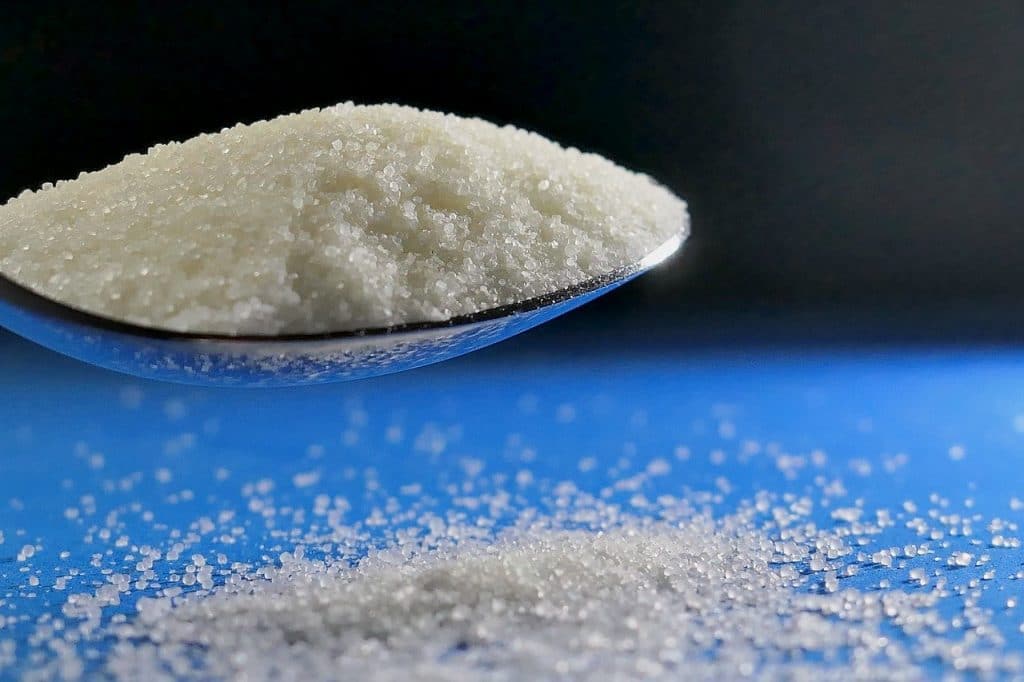
Salt and gout: should you be eating salt if you suffer with gout? And, if you can, is one type better than another? Read on to discover how salt affects gout and why you need to consider its impact on your overall health rather than just your gout.
Salt and Gout
Salt
Dietary salt is a mineral composed of sodium chloride (chemical formula NaCl) in the ratio 40% sodium (Na) to 60% chloride (Cl), by weight.
Salt has been used as a flavoring and food preservative for millennia: the world’s oldest known saltworks at Xiechi Lake in China dates back to 6000 BC.
There are two main sources of salt: seawater and salt deposits.
Sea salt is produced by solar and wind evaporation of salt water in shallow ponds fed by seawater or saltwater lakes. The salt that remains after evaporation is then harvested and processed.
And because there’s minimal processing the final product still contains small amounts of trace minerals, such as magnesium, manganese, calcium, potassium, zinc, iron, and iodine.
Rock salt (also known as halite) is mined and minimally processed from underground salt deposits. These underground salt beds were formed millions of years ago as ancient seas and salt water lakes slowly evaporated leaving deep horizontal salt beds that were then overlaid by layer-upon-layer of sediment as the geology slowly changed over time.
Table salt is mostly produced using a process that injects clean water into underground salt deposits to form a salty brine that is then pumped up to the surface where the salt is mechanically harvested, processed and refined to give it a fine texture.
This refining process removes most of the impurities but also the trace elements in the original salt. And, because it’s so highly refined, the finished product usually includes anticaking agents.
Many countries have legislated for adding iodine into table salt to help guard against iodine deficiency disorders in their populations. This is called iodised table salt.
Gout
The root cause of gout is excess amounts of uric acid in the blood — a condition called hyperuricemia — from which microscopic crystals of monosodium urate precipitate in the joints and associated tissue, triggering a gout attack (flare).
Uric acid is a byproduct of purine metabolism, which purines exist in our body’s cells and in the cells of the food we eat. Gout patients are usually advised to avoid or limit high-purine foods to help control their uric acid levels — alongside their urate lowering medication.
Salt and Uric Acid
Salt isn’t a problem as far as purines are concerned so, to that limited extent, it’s safe to eat with gout.
However, some long-term studies have shown that increased salt intake increases blood uric acid. On the other hand, several short-term studies suggest that a high sodium intake may help to lower uric acid in the blood; so there’s an ongoing debate within the expert community.
You can see, then, that a lot more work is required to fully understand the relationship between salt/sodium and uric acid.
So should you be eating salt if you have gout?
Whether or not salt is safe to eat with gout is entirely the wrong question.
You have to look at it from the point of view of your overall health since studies have linked high salt diets with high blood pressure and an increased risk of coronary heart disease, heart failure, heart attack, and stroke.
Salt has also been linked with fluid retention, kidney problems, and even osteoporosis.
So the question isn’t so much whether or not salt is safe in a gout diet but if you should be consuming it at all.
Do You Need Salt?
Do you actually need salt? Well, yes you do. Your body needs some sodium to control fluid balance and the way your muscles and nerves function. You’d die without it!
Even the ancients realized it’s importance: The expression to be “worth one’s salt” — meaning deserving of what you’re paid — may come from Roman soldiers who were sometimes paid in salt or given an allowance to buy it. And the English salary comes from the Latin salarium argentum which referred to the Roman soldier’s monetary allowance for salt.
So we definitely need sodium.
But how much?
How Much Sodium is Safe?
Most expert bodies recommend that adults should consume no more than 2.3 to 2.4 g of sodium per day: approx. 6 g of salt per day; roughly a teaspoon. But this includes salt already in processed foods, salt added in cooking, and salt added at the table.
Is sea salt and rock salt safer than table salt?
Many people think that sea salt and rock salt are healthier than table salt because they have less sodium and contain several trace minerals.
In fact, neither sea salt nor rock salt is a healthier alternative to table salt since all three salts have the same amount of sodium, around 40% by weight.
And there are only relatively small amounts of beneficial trace minerals in sea salt and rock salt, which minerals are found — sometimes in higher concentrations — in a variety of natural foods, making them a much healthier source.
Food Labelling
It’s very important not to confuse salt and sodium figures on food labels: they aren’t the same thing.
Some food labels only display the sodium content which understates, by some margin, how much salt there actually is in the product.
There’s a way around this though.
Remember, sodium accounts for 40% of salt. And 100% (salt) divided by 40% (sodium) = 2.5.
So, to convert sodium to salt, simply multiply the sodium amount shown on the label by 2.5. For example, 1 g of sodium per 100 g (on the label) is 2.5 g of salt per 100 g.
Are you consuming too much salt?
Here’s How to Reduce Your Salt Intake
According to the World Health Organization (WHO) most of us consume too much salt: as much as 9 to 12 g a day, up to twice the recommended daily maximum of 6 g.
So, if you’re eating too much salt, take steps to reduce your intake.
Start by gradually reducing the amount of salt you add to your food, until you can leave it out altogether. Your taste buds will eventually adjust.
And limit processed and convenience foods — which you should be doing anyway if you suffer from gout — which account for around 75 % of the salt we consume.
Remember, your recommended maximum daily allowance is equivalent to 1 teaspoon of salt including the salt in, and on, your food…so it doesn’t take much to go over the limit!
In any case, you’ll get plenty of sodium from natural foods, such as meats, seafood, eggs, vegetables, and dairy produce. And even although as a gout sufferer you need to avoid or limit some types of meat and seafood, there are still plenty of gout-safe foods to supply your sodium needs.



